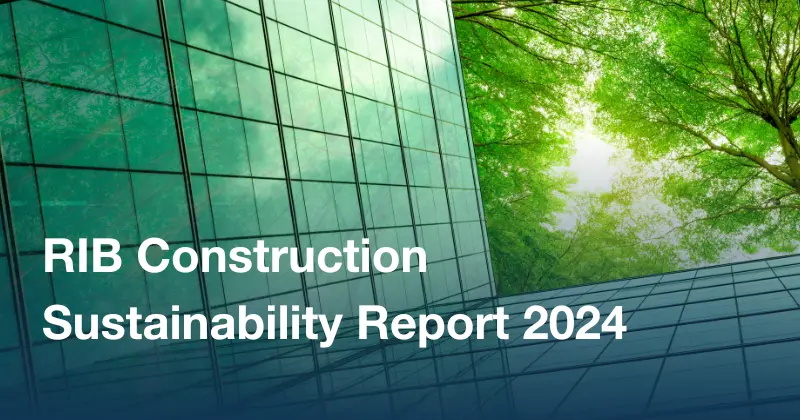11 mins read
What is EC3? – Reducing the Impact of Embodied Carbon

Towards the middle of this century, as the world’s population approaches 10 billion, construction is predicted to double in size. That’s the equivalent of adding an entire New York City to the planet every month for the next 40 years. While this is good news for the industry, it’s bad news for the environment. According to the Green World Building Council, buildings and construction are currently responsible for 39% of carbon emissions globally; with 28% from operational carbon and 11% from embodied carbon.
What is the difference between embodied carbon and operational carbon?
Embodied carbon is the CO2 emitted when producing materials. It is measured based on the energy used to extract and transport raw materials as well as emissions that result from manufacturing processes. In the construction industry, it is the carbon footprint of a building from cradle to grave and includes the CO2 produced when maintaining the building, demolishing it, transporting the waste, and recycling it.
Operational carbon refers to all energy sources used to keep buildings at the right temperature, ventilated, illuminated, and powered. The ‘carbon’ part of operational carbon is a stand-in for all the greenhouse gases released from these various energy sources.
The modern green-building movement is only a few decades old, but during that time, its focus has been on reducing operational energy. The highly visible nature of these operations and the ease of measuring progress have led to many successes.
However, understanding the carbon footprint of the entire supply chain for materials and construction is not only less obvious and visible, but until recently, it has proven to be much more difficult to calculate.
Measuring embodied carbon in the construction industry
The best way to reduce the impact of embodied carbon is to measure it. Only then can we compare, verify, track, and declare it with any degree of accuracy or governance. That’s exactly why key players in the industry, including RIB Software, have partnered to sponsor Building Transparency’s Embodied Carbon in Construction Calculator (EC3), a revolutionary tool that is turning what has, up until recently, been an inexact science into an increasingly exact one that helps to quantify and measure embodied carbon and its impact on building projects.
What is EC3, and what makes it unique?
EC3 houses a global database of digital, third-party-verified Environmental Product Declarations (EPDs), which can be used to perform sustainable construction benchmarking and assessments.
This is particularly useful to construction material procurers, developers, contractors, and policymakers alike because it enables them to measure the amount of embodied carbon within materials. Stakeholders can also evaluate a project’s overall carbon footprint and use that information to procure low-carbon material alternatives or, in the case of regulators, set embodied carbon limits.
Armed with this information, they can chart tangible targets and collectively help minimize the industry’s impact on the environment, such as reducing the high volume of material waste that occurs within the industry or the need to rework construction structures.
Until recently, material suppliers found it challenging and expensive to publish EPDs which are required to analyse the embodied carbon emissions associated with a building. Moreover, the relatively small number of EPDs that were published could only be found in scattered databases, many of them proprietary and competing with each other. Finally, virtually all EPDs were print-only PDF files; making them hard to find and difficult to evaluate or compare digitally.
With the launch of EC3, thousands of digital EPDs are now available in one easily accessible database, and thousands more are being added as stakeholders around the globe join the movement to take responsibility for reducing their carbon footprints. As a result, building designers, construction companies, and material suppliers can now directly measure and compare the embodied carbon in their new buildings.
What’s more, as each new EPD enters the database, it provides a new benchmark for subsequent projects; thereby creating a snowball effect of improvement in construction practices for the benefit of the entire planet.
In summary, EC3 empowers construction and associated companies to:
- Find and compare materials through simple sorting and visualization of supply-chain-specific EPD data.
- Plan and compare buildings through simple visualization of a project’s potential and realized, upfront embodied carbon emissions, ensuring achievable reduction targets are set.
- View specific EPD data per product in a standardized digital format.
- Audit and verify digital EPDs.
Combining the power of EC3 and software technology to reduce the impact of embodied carbon
While Building Transparency’s EC3 technology provides the core foundation for the quantification of embodied carbon across various products and materials, the ability to easily extract the embodied carbon data for comparison against project time and cost has been absent.
Driven by disruptive digital construction technologies, industry best-practice and trends; RIB is making it their purpose to propel the industry forward to ensure engineering and construction are more efficient and sustainable. Leading the way for future sustainability solutions that are trusted, easy to use and access by the industries they serve; RIB’s world-leading 6D BIM CostX solution empowers industry professionals to quantify, measure, report on and compare embodied carbon across the project lifecycle. It is the first solution globally that integrates embodied carbon accounting with cost estimating. What’s more, RIB CostX can import EC3 rates directly, enabling even better design and procurement decisions.
Continued development of RIB’s solutions will enable more informed decisions that factor in cost, time, and sustainability to mitigate and, ultimately, eliminate embodied carbon produced throughout the life of a building. With these new models of collaborative development powered by connected data, the goal is to cut greenhouse gas emissions dramatically in less than a generation.
If you are ready to be a part of change and start tracking the environmental impact of your projects with our professional carbon estimating software, get a free demo today!
Most Recent
11 mins read
10 mins read
10 mins read
29 mins read
Blog Categories

Ebook










